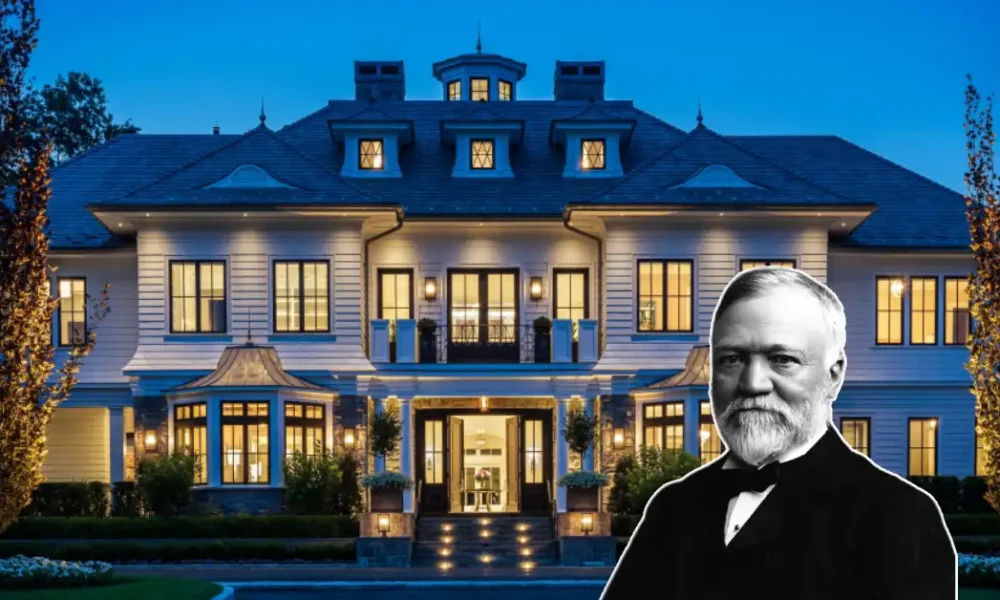The Andrew Carnegie House stands tall in the heart of Manhattan’s Carnegie Hill, a bold and forward-thinking mansion once owned by one of history’s wealthiest and most generous men. Built between 1899 and 1902, this grand home wasn’t just a place to live—it was a quiet fortress of steel and style, a home ahead of its time. With 64 rooms and the distinction of being the first American residence with a steel frame and a private elevator, it was a marvel of innovation during the Gilded Age. Now known as the Carnegie Mansion in New York, it proudly houses the Cooper Hewitt Smithsonian Design Museum. But long before museum-goers walked its halls, Andrew Carnegie and his family made this place a home that whispered both luxury and purpose. From its lush private garden to advanced home technologies, the Andrew Carnegie House remains one of the most important historic mansions NYC has ever seen.
Who is Andrew Carnegie?
Andrew Carnegie was a self-made industrialist who rose from humble beginnings in Scotland to become a titan of the American steel industry. After selling his company, Carnegie Steel, for $480 million in 1901, he didn’t just retire—he rewrote what retirement could look like. Instead of settling quietly, he turned his attention to giving back. He believed in using wealth to uplift others and poured over $350 million into public libraries, education, world peace, and science. Many know him today as one of the greatest philanthropists in history. His home—the Andrew Carnegie House—wasn’t just a place to rest his head. It became a base for his charitable ventures and a quiet personal life with his wife Louise and their daughter Margaret. Everything about this home reflects his legacy—grand yet grounded, innovative yet personal.
Andrew Carnegie House & Location
Nestled on the corner of Fifth Avenue between 90th and 91st Streets, the Andrew Carnegie House was built far north of where the wealthy elites lived at the time. Carnegie deliberately chose this location for one reason: space. He wanted a large garden and quiet surroundings—rare features in bustling New York. Today, this neighborhood is known as Carnegie Hill, named in his honor. While other Fifth Avenue mansions scream for attention, this house whispers class and intention. The location also allowed him to live near nature while still staying connected to the heart of the city. The Andrew Carnegie residence set a trend for future uptown development, showing how visionaries often shape not only industries but cities, too.
Features of the Andrew Carnegie House
- 64-room Georgian Revival mansion
- Built with a structural steel frame construction
- Includes a residential Otis passenger elevator (historic)
- An early form of a central heating and air conditioning system
- Red brick with limestone trim and slate roof
- Located on Fifth Avenue, Carnegie Hill, NYC
- Rare large private garden with 30,000 tulips
- Home included a philanthropic work office
- Landmark status since 1974
- Converted into the Cooper Hewitt Smithsonian Design Museum
- Underwent renovations from 2008 to 2014
House Design and Style
The Carnegie Mansion architecture is a beautiful blend of Georgian Revival with touches of Beaux-Arts elegance. Designed by Babb, Cook & Willard architects, the house features a timeless red brick façade trimmed with limestone. The steep slate roof adds an old-world charm, while the steel frame was light years ahead of its time. Inside, the flow from room to room was both functional and grand, with generous natural light, high ceilings, and intricate woodwork. Carnegie didn’t just want beauty—he wanted the best engineering could offer. That’s why this home became the first in the nation to feature a steel frame mansion structure, laying the groundwork for skyscrapers. And thanks to the elevator and smart heating systems, it was practically futuristic back in the early 1900s.
Personal House Touches
Every corner of the Andrew Carnegie House tells a personal story. While other Gilded Age homes focused on gold-plated luxury, Carnegie added warmth and thoughtfulness. His daughter Margaret had a sunny playroom overlooking the garden. His wife, Louise, added her favorite tulips to the garden—30,000 of them. And Carnegie himself kept a peaceful study where he wrote letters, planned library donations, and met guests.
Other unique personal touches include:
- A miniature train system to transport coal to the boiler room
- Secret passages for quiet access to different wings
- A private library with over 7,000 books
- A quiet rear wing that served as his home office
- A music room for evening gatherings and guests
Interior Design & Highlights
Inside the Andrew Carnegie House, elegance met innovation. You’ll find handcrafted oak paneling, marble fireplaces, and ceilings with detailed plasterwork. But it wasn’t just about style—this house had substance. The Otis passenger elevator moved floors seamlessly. The large dining room was used not only for meals but for meetings with scholars, educators, and diplomats. The home even had modern plumbing and insulated walls, unheard of at the time. Today, the Smithsonian Design Museum, its grand staircase, skylit hallways, and original architectural details still reflect Carnegie’s vision. It’s a home that combines practical comfort with refined aesthetics, like a masterpiece that was built to last.
Outdoor House Spaces
Carnegie’s love for nature led him to design an incredible garden—something Manhattan rarely sees. The mansion’s yard stretches over an acre, offering a peaceful break from the city noise. Today, it’s known as the Arthur Ross Garden. Originally designed to include walking paths, fountains, and floral patterns, this garden has been restored with more than 30,000 tulips and various native plants. It’s an urban oasis in a city that rarely stops moving. This private space reflects Carnegie’s desire for reflection and peace. And even now, it continues to provide calm to museum visitors and neighbors alike.
Market Value and Comparisons
Back in 1972, when the Carnegie Corporation donated the house to the Smithsonian Institution, it was valued at $8 million—a jaw-dropping amount for the time. Over the years, the home has gained not just in financial worth but in cultural and architectural value. While it’s hard to give an exact figure today since the house is now a landmarked museum, comparable historic house museums in NYC rarely reach the same level of preservation and prominence. Carnegie’s foresight in choosing location, design, and innovation has turned the home into a priceless national treasure.
Purchase History & Estimated Market Table
| Year | Owner | Status/Use | Estimated Value |
|---|---|---|---|
| 1902 | Andrew Carnegie | Private Family Residence | ~$1 million (1900s) |
| 1946 | Carnegie Family Estate | Vacant / Holding Period | ~$3 million |
| 1972 | Smithsonian Institution | Museum Gifted by Carnegie Corp. | $8 million |
| 2025 | Not for Sale | Public Museum (Landmark Status) | $ 80 M+ (Est. Cultural) |
Other Houses Owned by Andrew Carnegie
While the Andrew Carnegie House in NYC is his most famous home, historical records show he didn’t invest heavily in multiple personal estates. Instead, he focused his energy and finances on:
- Skibo Castle, Scotland – His summer retreat, later donated for public use
- A modest summer cottage in the Catskills, New York
- Occasional stays at hotel suites during travels for philanthropy
Unlike other tycoons, Carnegie didn’t build a chain of lavish estates. He believed in legacy through ideas, not only land.
Conclusion
The Andrew Carnegie House is more than just a mansion—it’s a symbol of innovation, purpose, and timeless design. From its steel frame to its blooming tulip gardens, every brick holds a story. Carnegie’s home didn’t just shelter a family—it became a cornerstone of cultural and architectural evolution. Now, as the Cooper Hewitt Smithsonian Design Museum, it continues to inspire millions with creativity, history, and beauty. Whether admired for its past or visited for its present, this landmark remains one of the most beloved and important homes in all of New York City.




No Comment! Be the first one.